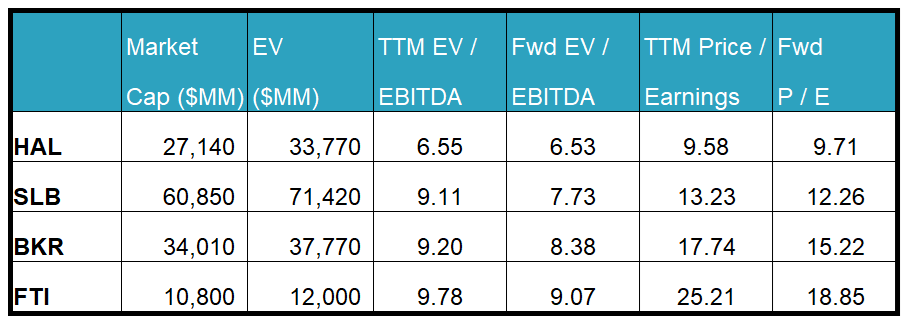Industry Outlook and HAL’s Strategies
We have already discussed Halliburton’s (HAL) Q2 2024 financial performance in our recent article. The management expects high activity levels and equipment tightness in its international markets in 2024. As a result, it expects steady growth in 2H 2024. In FY2024, the company anticipates 10% revenue growth in its international business. However, it expects revenues from North America to decline by 6% to 8% in 2H 2024 compared to a year earlier. This would mark one of the low points in the current cycle.
Although the company fell short of providing specific guidance for 2025, it expects increased activity after the recent E&P consolidation in the upstream industry. Following the slew of upstream mergers, some of the merged assets can be divested to smaller operators. Also, natural gas activity will see some recovery. Even with the previous downturn, its C&P (Completion and Production) division maintained strong margins. This also gives the management the confidence to be resilient in the current natural gas market downturn.
Frac Outlook
HAL retired a few frac spreads in Q2 following its strategy of prioritizing returns over market share and offering differentiated technologies in the US. These strategies have produced steady returns in the domestic market. One of its latest technology solutions is Octiv, a key component of the ZEUS platform. Octiv delivers an automation solution called AutoFrac in large multi-well pads. It autonomises frac job from the ramp up at the start to the ramp down at the end. Following commercial trials, AutoFrac appears to be ready to scale for the customers.
In North America, the footage drilled by HAL’s iCruise rotary steerable system has more than doubled over last year, as we discussed in our previous article. It estimates that in the Permian Basin, the number of rigs running the system has increased by 45% since the start of this year. The company plans to triple its footage drilled in North America in 2024.
In Q3, the management expects the C&P division revenue to decline by 1%-3%, while operating margins can decrease by 75-125 basis points. The Drilling and Evaluation division expects revenue to increase by 2%-4% and margins to increase by 25-75 basis points in Q3.
Key Drivers
HAL’s artificial lift product line growth in the international markets is 2x that of its overall international growth. This also marks additions from bolt-on acquisitions in the past. In Q2, it launched the GeoESP line, which is engineered for the harsh geothermal environment. GeoESP line solves extreme thermal cycling, scale development, abrasion, and corrosion. HAL strengthened its unconventional drilling in international markets through the iCruise X rotary steerable system and the LOGIX autonomous drilling platform.
As a result, the Middle East’s drilling services revenue grew by about 30% year-over-year in Q2. Halliburton’s management promotes technological innovations like unified ensemble modeling, scalable earth model, AI, iEnergy cloud platform, and machine learning. These tools can increase customers’ efficiencies from asset-level planning through production.
Key Q2 Metrics
We already discussed HAL’s Q2 2024 financial performance, cash flows, and balance sheet in our Halliburton: Q2 TAKE THREE article. Geographically, North America and Latin America witnessed a fall (2.6% and 1% down) compared to a 5.4% rise in the Middle East/Asia in Q2 from Q1. The company’s Europe/Africa/CIS saw a topline rise.
HAL’s cash flow from operations increased by 34% in 1H 2024 compared to a year ago. Debt-to-equity (0.76x) also showed clear improvement from Y2023. During Q2, it repurchased shares worth $250 million to improve shareholder returns.
Relative Valuation

Halliburton is currently trading at an EV/EBITDA multiple of 6.6x. Based on sell-side analysts’ EBITDA estimates, the forward EV/EBITDA multiple is nearly unchanged. The current multiple is lower than its five-year average EV/EBITDA multiple of 11.3x.
HAL’s forward EV/EBITDA multiple change versus the adjusted current EV/EBITDA is in contrast to a decline in the multiple for its peers because the company’s EBITDA is expected to remain unchanged versus a rise in EBITDA for its peers in the next four quarters. This typically results in a lower EV/EBITDA multiple than peers. The stock’s EV/EBITDA multiple is lower than its peers’ (SLB, BKR, and FTI) average. So, the stock is reasonably valued versus its peers.
Final Commentary
In 2H 2024, HAL expects its topline to improve in international markets, although it can deteriorate in North America. Natural gas prices will likely stay under pressure but can see recovery in 2025, leading to a stronger margin in the C&P division. In fracking, the company retired a few frack spreads in Q2 as returns fell. It has introduced various new technologies and autonomous solutions in the large multi-well pads to ramp frac jobs and allow scalability for its customers.
Also, the company’s artificial lift products saw impressive growth in international markets. It has introduced GeoESP line, iCruise X rotary steerable system, and the LOGIX autonomous drilling platform. With improved cash flows in 1H 2024, shareholder returns increased through share repurchase. The stock is reasonably valued versus its peers at this level.













